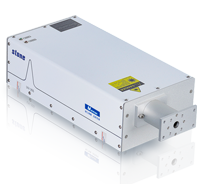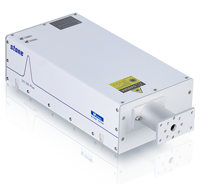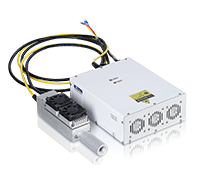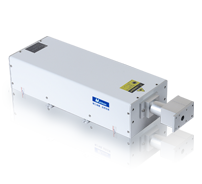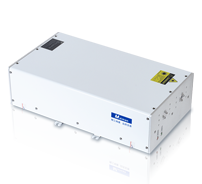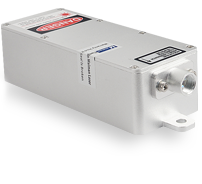Laser of solid laser material used as working substance for solid state laser. In 1960, the T.H. ruby laser was solid-state laser and the first laser in the world. Solid laser is usually composed of laser working material, excitation source, condensing cavity, resonator, reflector and power supply.
The solid working material employed in such lasers is the incorporation of metal ions with stimulated emission of metals into crystals. There are mainly three kinds of metal ions which can produce stimulated emission in solid: (1) transition metal ions (such as Cr3+); (2) most lanthanide metal ions (such as Nd3+, Sm2+, Dy2+, etc.); (3) actinide metal ions (such as U3+). The main characteristics of doped metal ions in solid matrix has the effective absorption spectrum of wide band, high fluorescence efficiency, long fluorescence lifetime and relatively narrow fluorescence spectra, so it is easy to produce inversion and stimulated emission. As a kind of artificial crystal crystal matrix are: corundum (NaAlSi2O6), yttrium aluminum garnet (Y3Al5, O12), calcium tungstate (CaWO4), calcium fluoride (CaF2), and yttrium aluminate (YAlO3), lanthanum beryllate (La2Be2O5) etc.. The glass matrix is mainly made of high quality silicate optical glass, such as commonly used barium crown glass and calcium crown glass. Compared with the crystal matrix, the main characteristics of glass matrix are easy preparation and easy access to large-size high-quality materials. The main requirements of crystal and glass matrix is readily incorporated into activation of light metal ions; has good spectral characteristics, optical transmittance and high optical properties (refractive index) uniformity; with the physical and chemical properties suitable for long-term operation of the laser (such as thermal properties, anti degradation properties, chemical stability etc.). The crystal laser is represented by Al2O3:Cr3+ and neodymium doped yttrium aluminum garnet (YAG:Nd3+). Glass lasers are typical of neodymium glass lasers.
Working substance of solid laser
The working substance of a solid laser, consisting of optically transparent crystals or glass as the base material, doped with activated ions or other active substances. The working materials should have good physical and chemical properties, narrow fluorescence spectra, strong and broad absorption bands and high fluorescence quantum efficiency.
Glass laser working materials are easy to be made into even large size materials and can be used in high energy or high peak power lasers. But its fluorescence spectrum is wide, and its thermal performance is poor, so it is not suitable for working under high average power. Common Nd glass has silicate, phosphate, and fluor phosphate glass. In the early 80s, neodymium glass with negative refractive index negative temperature coefficient was developed. It can be used in medium and small energy lasers with high repetition rate.
Crystal laser working materials generally have good thermal and mechanical properties, narrow fluorescence lines, but the technology for obtaining high quality large size materials has complicated crystal growth. Since 60s, more than 300 kinds of rare earth metals or transition metal ion oxides and fluoride crystals have been adopted to realize laser oscillation. The ruby laser crystals (Cr:Al2O3, wavelength 6943 angstroms), neodymium doped yttrium aluminum garnet (Nd:Y3Al5O12, Nd:YAG, 1.064 micron wavelength), yttrium lithium fluoride (LiYF4, YLF; Nd:YLF, 1.047 or 1.05 micron wavelength; Ho:Er:Tm:YLF, wavelength of 2.06 microns).
Since 1973, there has been a class of self activated laser crystals. Its active ion is a chemical component of the crystal, so the activation ion concentration is high and does not produce fluorescence quenching. The laser gain of the crystal is high and the pumping threshold is low. The main varieties are five phosphoric acid neodymium (NdP5O14), four lithium phosphate neodymium (NdLiP4O12) and aluminum borate neodymium (NdAl3 (BO4) 3) and so on. They are grown by molten salt, which is small in size and can be used in small solid state lasers.
Is there a variety of broadband fluorescence characteristics of tunable laser crystal, such as terminal phonon transitions of alexandrite (Cr:BeAl2O4, wavelength 0.701 ~ 0.815 micron, room temperature), nickel doped magnesium fluoride (Ni:MgF2, 1.6 ~ 1.8 micron wavelength, low temperature), lithium yttrium fluoride cerium doped 5D to 4f transition (Ce:YLF from 0.306 to 0.315 microns, wavelength, excitation, with excimer laser operating at room temperature) color center laser crystal and the alkali halide (potassium chloride, not doped or doped lithium fluoride, the wavelength of 0.8 to 3.9 microns, mostly in low temperature).
Solid laser excitation source
Solid laser uses light as the excitation source. Filling xenon flash pulse excitation sources used; continuous excitation source with krypton arc lamp, halogen lamp, potassium rubidium lamp etc.. In small long-life lasers, semiconductor LED or sunlight can be used as the source of excitation. Some new solid-state lasers also have laser excitation.
Solid laser because the light source is only a part of the emission spectrum absorbed by the working substance, coupled with other losses, so the energy conversion efficiency is not high, generally between a few thousandths to a few percent.
Solid-state laser characteristics
Solid laser can be used as large energy and high power coherent light source. The output energy of ruby pulse laser is up to kj. The highest pulse power of 10 watts is achieved by the modulated Q and multistage amplified Nd glass laser system. The output power of Dabaiwa yttrium aluminum garnet laser, multi-stage tandem up to kilowatts.
Using Q switching technology (light modulation), solid-state lasers can obtain short pulses ranging from nanosecond to nanosecond, and can obtain ultrashort pulses ranging from picosecond to 100 picoseconds by mode locking technique.
The output of the general solid-state laser is multi-mode because of the optical inhomogeneity of the working substance. If the use of optical uniformity of the work of good materials and carefully designed resonant cavity, etc.










.png)
